Themed collection Materials Horizons 10th anniversary regional spotlight collection: Europe

Bioinspired double network hydrogels: from covalent double network hydrogels via hybrid double network hydrogels to physical double network hydrogels
This minireview discusses the advantages and challenges in constructing bioinspired double-network hydrogels mimicking the structure and/or properties of biological tissue.
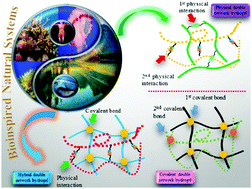
Mater. Horiz., 2021,8, 1173-1188
https://doi.org/10.1039/D0MH01514H
Evolution of self-healing elastomers, from extrinsic to combined intrinsic mechanisms: a review
We propose a timeline classifying self-healing polymers in generations based on the healing mechanism, and correlated with historical development.
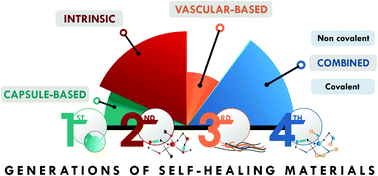
Mater. Horiz., 2020,7, 2882-2902
https://doi.org/10.1039/D0MH00535E
Dual emission in purely organic materials for optoelectronic applications
In this review, types and mechanisms of dual emission, as well as recent new insights for the design and applications of efficient novel dual emissive organic materials are presented.
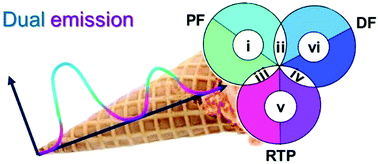
Mater. Horiz., 2021,8, 33-55
https://doi.org/10.1039/D0MH01316A
It's a trap! On the nature of localised states and charge trapping in lead halide perovskites
The recent surge of scientific interest for lead halide perovskite semiconductors and optoelectronic devices has seen a mix of materials science sub-fields converge on the same “magical” crystal structure.
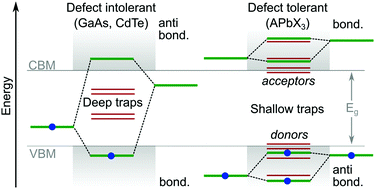
Mater. Horiz., 2020,7, 397-410
https://doi.org/10.1039/C9MH00500E
Advances in designs and mechanisms of semiconducting metal oxide nanostructures for high-precision gas sensors operated at room temperature
A comprehensive review on designs and mechanisms of semiconducting metal oxides with various nanostructures for room-temperature gas sensor applications.

Mater. Horiz., 2019,6, 470-506
https://doi.org/10.1039/C8MH01365A
The evolution of ‘sol–gel’ chemistry as a technique for materials synthesis
From its initial use to describe hydrolysis and condensation processes, the term ‘sol–gel’ is now used for a diverse range of chemistries.
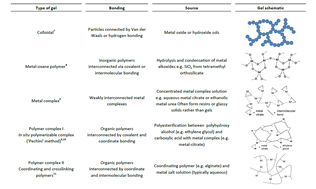
Mater. Horiz., 2016,3, 91-112
https://doi.org/10.1039/C5MH00260E
Protein corona formation around nanoparticles – from the past to the future
Existing analytical models, such as the Hill model, are a powerful tool to understand the process of protein binding to nanoparticles.
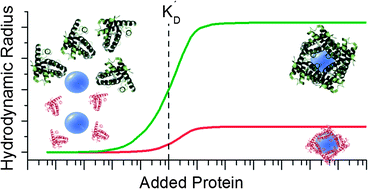
Mater. Horiz., 2014,1, 301-313
https://doi.org/10.1039/C3MH00106G
A pyridine-capped quaterthiophene as an alternative to PEDOT:PSS, processable from organic solvents and without acidity, for more stable electronic devices
Doped quater(3,4-ethylenedioxythiophene), capped either side of the chain with two pyridine units, is a promising alternative to PEDOT:PSS, as it removes the issue of acid-induced degradation of devices caused by PEDOT:PSS.

Mater. Horiz., 2023,10, 5087-5098
https://doi.org/10.1039/D3MH01060K
Polymorph screening at surfaces of a benzothienobenzothiophene derivative: discovering new solvate forms
Variation of the thin-film preparation conditions identifies application-relevant polymorphs for particular molecular materials, where crystallization at surfaces enables the discovery of additional phases compared with classical polymorph screening.

Mater. Horiz., 2023,10, 4415-4422
https://doi.org/10.1039/D3MH00764B
Optimization of thermoelectric properties of carbon nanotube veils by defect engineering
Defect engineering of CNT veils, by stretching and heat-repairing, is shown to be a method for optimising thermoelectric performances, as thermal conductivity can be reduced without significantly affecting Seebeck voltage and electrical conductivity.

Mater. Horiz., 2023,10, 3601-3609
https://doi.org/10.1039/D3MH00525A
Microscopic strain mapping in polymers equipped with non-covalent mechanochromic motifs
We present a generalisable methodology based on fluorescent non-covalent mechanophores for producing quantitative maps of local strain around defects within three-dimensional polymeric matrices.
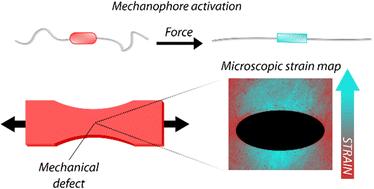
Mater. Horiz., 2023,10, 3467-3475
https://doi.org/10.1039/D3MH00650F
3D organic bioelectronics for electrical monitoring of human adult stem cells
Conducting polymer scaffolds enable electrical monitoring of the growth of three-dimensional human adult stem cell cultures and facilitate their differentiation into neuron-like cells.

Mater. Horiz., 2023,10, 3589-3600
https://doi.org/10.1039/D3MH00785E
Flexible triboelectric nanogenerators using transparent copper nanowire electrodes: energy harvesting, sensing human activities and material recognition
A high performance flexible triboelectric nanogenerator using oxidation resistant pure copper nanowire electrodes.

Mater. Horiz., 2023,10, 3124-3134
https://doi.org/10.1039/D3MH00404J
A cold-responsive liquid crystal elastomer provides visual signals for monitoring a critical temperature decrease
A new generation of critical temperature indicators is developed for monitoring temperature decrease and providing irreversible visual signals. This is realized by using a switchable permeable–impermeable gold-liquid crystal elastomer membrane.

Mater. Horiz., 2023,10, 2649-2655
https://doi.org/10.1039/D3MH00271C
On the mechanistic complexity of oxygen evolution: potential-dependent switching of the mechanism at the volcano apex
The volcano plot for oxygen evolution, consisting of a plethora of different reaction mechanisms, reveals mechanistic changes in dependence of the descriptor (ΔG1) and potential-dependent switching of the preferred pathway at the volcano apex.
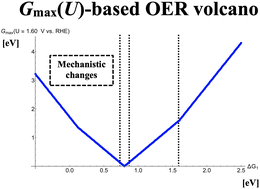
Mater. Horiz., 2023,10, 2086-2095
https://doi.org/10.1039/D3MH00047H
What is special about Y6; the working mechanism of neat Y6 organic solar cells
Morphological modification by DIO additive facilitates charge generation in the bulk of Y6, suppresses the bimolecular recombination, which results in an increased JSC and FF of single component Y6 solar cells.

Mater. Horiz., 2023,10, 1825-1834
https://doi.org/10.1039/D2MH01411D
Universal ion-transport descriptors and classes of inorganic solid-state electrolytes
A comprehensive first-principles database is introduced for prototypical families of inorganic solid-state electrolytes containing sets of zero-temperature DFT and finite-temperature ab initio molecular dynamic results.

Mater. Horiz., 2023,10, 1757-1768
https://doi.org/10.1039/D2MH01516A
MOF/polymer hybrids through in situ free radical polymerization in metal-organic frameworks
A simple yet powerful strategy of carrying out free radical polymerization of methacrylate monomers using a MOF-based initiator. The obtained composites maintain high catalytic activity towards a chemical warfare agent (CWA) simulant.
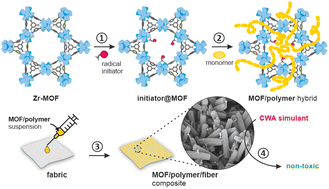
Mater. Horiz., 2023,10, 1301-1308
https://doi.org/10.1039/D2MH01202B
Dual redox-active porous polyimides as high performance and versatile electrode material for next-generation batteries
Design of dual redox-active porous polymers towards high-energy density and performance organic electrode materials for lithium metal battery and symmetric all-organic battery applications.

Mater. Horiz., 2023,10, 967-976
https://doi.org/10.1039/D2MH01335E
Recyclable thermosets based on modified epoxy-amine network polymers
A simple, single stage process is reported for the creation of a recyclable thermoset material from readily available epoxy resins and aliphatic amines, crosslinked with diboronic esters.
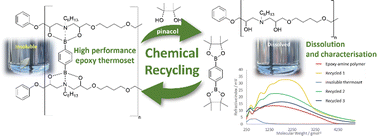
Mater. Horiz., 2023,10, 889-898
https://doi.org/10.1039/D2MH01211A
Passive climate regulation with transpiring wood for buildings with increased energy efficiency
The transpiring wood is able to self-regulate indoor climate resulting in improved living comfort and substantial energy savings. The material sources and the fabrication process of transpiring wood also meet sustainability criteria.

Mater. Horiz., 2023,10, 257-267
https://doi.org/10.1039/D2MH01016J
Spectroscopic analysis of vibrational coupling in multi-molecular excited states
Temperature dependent luminescence of multi-molecular excited states like excimers and charge-transfer states is described by a Frank–Condon model based on an inter-molecular vibrational mode and different potentials for the ground and excited state.
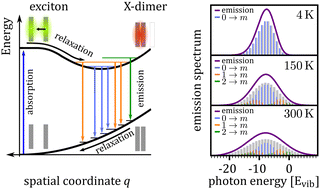
Mater. Horiz., 2023,10, 221-234
https://doi.org/10.1039/D2MH00829G
Frequency-dependent stimulated and post-stimulated voltage control of magnetism in transition metal nitrides: towards brain-inspired magneto-ionics
A voltage-controllable N ion accumulation effect at the outer surface of CoN films, enabling ‘post-stimulated’ learning or forgetting under deep sleep (once voltage stimuli are off), is demonstrated, triggering the development of synapse emulation.
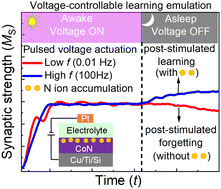
Mater. Horiz., 2023,10, 88-96
https://doi.org/10.1039/D2MH01087A
Control of up-to-down/down-to-up light-induced ferroelectric polarization reversal
Control of the final state of polarization switched by illumination is achieved in BaTiO3 films by the manipulation of the internal electric fields by using suitable bottom electrodes.
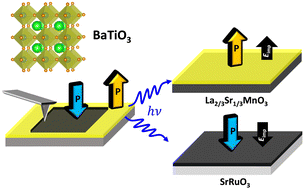
Mater. Horiz., 2022,9, 2345-2352
https://doi.org/10.1039/D2MH00644H
Effect of electronic doping and traps on carrier dynamics in tin halide perovskites
Interplay of radiative and non-radiative recombination processes in tin halide perovskites as a result of doping, oxidation and defects.

Mater. Horiz., 2022,9, 1763-1773
https://doi.org/10.1039/D2MH00008C
Elastomeric microwell-based triboelectric nanogenerators by in situ simultaneous transfer-printing
An ultrastretchable triboelectric nanogenerator is developed by simultaneous transfer printing. The nanogenerator demonstrates all-in-one, self-powered touch, motion and force sensing that can function as artificial skin for soft robotic components.
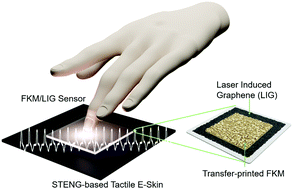
Mater. Horiz., 2022,9, 1468-1478
https://doi.org/10.1039/D2MH00074A
Pickering emulgels reinforced with host–guest supramolecular inclusion complexes for high fidelity direct ink writing
Direct ink writing (DIW) of Pickering emulsions offers great potential for constructing on-demand objects.
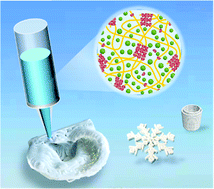
Mater. Horiz., 2022,9, 835-840
https://doi.org/10.1039/D1MH01741A
Self-glucose feeding hydrogels by enzyme empowered degradation for 3D cell culture
Self-feeding hydrogels were fabricated to obtain structural platforms for 3D cell culture but also achieving an autonomous release of glucose over time to prolong cell’s survival in-vitro and in-vivo.
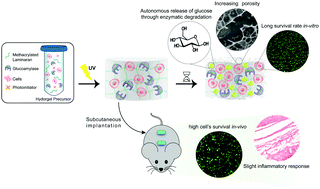
Mater. Horiz., 2022,9, 694-707
https://doi.org/10.1039/D0MH01982H
Freeform direct laser writing of versatile topological 3D scaffolds enabled by intrinsic support hydrogel
By combining a photocurable and a thermogelling hydrogel, it is possible to perform 3D freeform structuring via two-photon-polymerization and to manufacture concatenated parts without additional support structures.
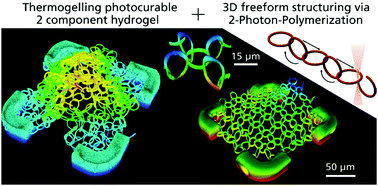
Mater. Horiz., 2021,8, 3334-3344
https://doi.org/10.1039/D1MH00925G
Exploring the anion chemical space of Ln2OF2−xClxH2 (Ln = Y, La, Gd): a model of electroelastic material with high mechanical sensitivity and energy harvesting
The focus of our research was to design a novel inorganic material that would combine enhanced compressibility with high piezoelectric constants.

Mater. Horiz., 2021,8, 577-588
https://doi.org/10.1039/D0MH01524E
Machine-learning interatomic potentials enable first-principles multiscale modeling of lattice thermal conductivity in graphene/borophene heterostructures
We highlight that machine-learning interatomic potentials trained over short AIMD trajectories enable first-principles multiscale modeling, bridging DFT level accuracy to the continuum level and empowering the study of complex/novel nanostructures.
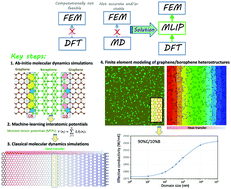
Mater. Horiz., 2020,7, 2359-2367
https://doi.org/10.1039/D0MH00787K
Dramatic increase in polymer triboelectrification by transition from a glassy to rubbery state
Glassy polymers show an impressive surge in triboelectric surface charge when crossing their respective Tg. In a rubbery state they become softer and more adhesive, therefore heterolysis of polymer bonds and material transfer becomes more probable.
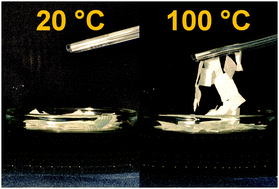
Mater. Horiz., 2020,7, 520-523
https://doi.org/10.1039/C9MH01425J
Bionic synthesis of a magnetic calcite skeletal structure through living foraminifera
This communication describes the bionic preparation of a composite material in which fluorescent magnetite nanoparticles are included within the calcitic skeletal structure of the foraminifer Amphistrigina lessoni.

Mater. Horiz., 2019,6, 1862-1867
https://doi.org/10.1039/C9MH00495E
Quantification of ion migration in CH3NH3PbI3 perovskite solar cells by transient capacitance measurements
We quantify activation energy, concentration, and diffusion coefficient of mobile ions in MAPbI3 perovskite solar cells using transient ion-drift measurements.
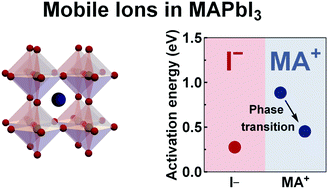
Mater. Horiz., 2019,6, 1497-1503
https://doi.org/10.1039/C9MH00445A
Ultrahigh hydrogen-sorbing palladium metallic-glass nanostructures
The hydrogenation mechanism in a Pd–Si–Cu metallic glass nanofilm, and its post-characterization by chronoamperometry/cyclic voltammetry and HR(S)TEM analyses.
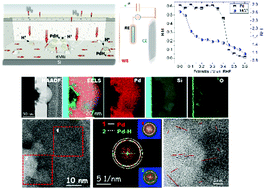
Mater. Horiz., 2019,6, 1481-1487
https://doi.org/10.1039/C9MH00316A
Reversely toposelective vapor deposition at normal pressure and temperature by capillary condensation
Nanotopography was utilized to coat previously hardest-to-reach surfaces and to bypass issues related to traditional vapor deposition methods.
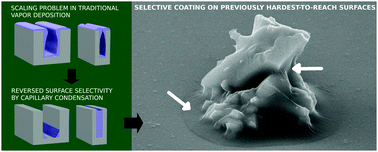
Mater. Horiz., 2019,6, 1230-1237
https://doi.org/10.1039/C8MH01523F
Close-loop dynamic nanohybrids on collagen-ark with in situ gelling transformation capability for biomimetic stage-specific diabetic wound healing
A self-regulated dynamic nanohybrid that can sensitively respond to hyperglycemic microenvironment is developed. The nanohybrid with a core/shell structure is produced through a single-step microfluidics nanoprecipitation method, where drugs-loaded porous silicon (PSi) nanoparticles are encapsulated by H2O2 responsive polymeric matrix.
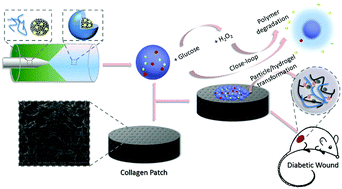
Mater. Horiz., 2019,6, 385-393
https://doi.org/10.1039/C8MH01145A
Focused ion beam milling of self-assembled magnetic superstructures: an approach to fabricate nanoporous materials with tunable porosity
Focused ion beam milling of self-assembled magnetic superstructures is demonstrated as a novel approach to fabricate porous materials with tunable porosity. During exposure to the ion beam, nanoparticles in the superstructure are subjected to combined milling and melting, thus merging together into a porous network.
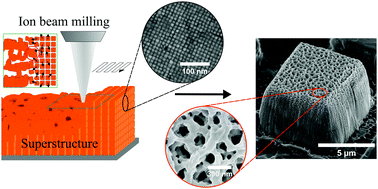
Mater. Horiz., 2018,5, 1211-1218
https://doi.org/10.1039/C8MH01112E
Room temperature control of spin states in a thin film of a photochromic iron(II) complex
Thin films of a molecular spin crossover iron(II) complex featuring a photochromic diarylethene-based ligand have been grown by sublimation in ultra-high vacuum on Au(111) and investigated by photoelectron spectroscopies.
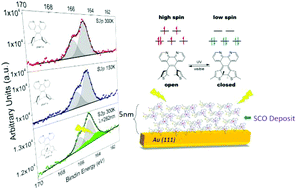
Mater. Horiz., 2018,5, 506-513
https://doi.org/10.1039/C7MH01042G
Rationally designed meta-implants: a combination of auxetic and conventional meta-biomaterials
Rationally designed meta-implants were found to create compression along both of their contact lines with the surrounding bone, thereby decreasing the chance of bone–implant interface failure (Hoffman's criterion) and wear particle-induced osteolysis, and improving bone ingrowth.

Mater. Horiz., 2018,5, 28-35
https://doi.org/10.1039/C7MH00699C
Mille-feuille paper: a novel type of filter architecture for advanced virus separation applications
Mille-feuille paper is the first non-woven, wet-laid filter paper, composed of 100% native cellulose, which is capable of removing the “worst-case” model parvoviruses from water with a log10 reduction value (LRV) >5 (>99.999%).

Mater. Horiz., 2016,3, 320-327
https://doi.org/10.1039/C6MH00090H
Charge selective contacts, mobile ions and anomalous hysteresis in organic–inorganic perovskite solar cells
“Compact layer-free” perovskite devices yield negligible stabilised power output, in comparison to those with charge selective contacts, elucidating mechanism for hysteresis.
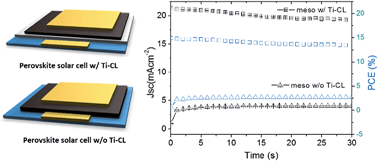
Mater. Horiz., 2015,2, 315-322
https://doi.org/10.1039/C4MH00238E
Controlled synthesis of conjugated random copolymers in a droplet-based microreactor
We report the highly controlled synthesis of conjugated random copolymers in a droplet-based microfluidic reactor.
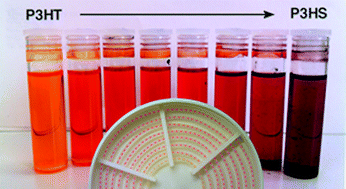
Mater. Horiz., 2014,1, 214-218
https://doi.org/10.1039/C3MH00066D
Catalyst-free room-temperature self-healing elastomers based on aromatic disulfide metathesis
Bis(4-aminophenyl) disulfide has been used as a dynamic crosslink for the design of self-healing elastomers, showing quantitative healing efficiency at room-temperature, without the need for any catalyst or external intervention.
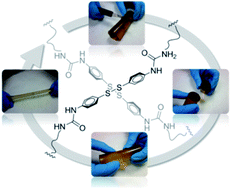
Mater. Horiz., 2014,1, 237-240
https://doi.org/10.1039/C3MH00061C
Large-area arrays of three-dimensional plasmonic subwavelength-sized structures from azopolymer surface-relief gratings
Azopolymer-based holographic templates create unique large-area arrays of three-dimensional plasmonic structures when combined with ion milling.
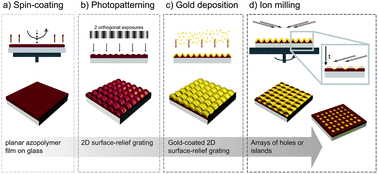
Mater. Horiz., 2014,1, 74-80
https://doi.org/10.1039/C3MH00008G
About this collection
To celebrate the 10th anniversary of Materials Horizons we have curated a collection of our most popular articles from our European contributors. For Materials Horizons it is of great importance that we represent a truly diverse array of authors and their research, to learn from each other and develop global strategies to conquer the most pressing issues in materials science. We would like to take this opportunity to thank all our contributors from Europe for continuing to provide high quality research to Materials Horizons. We strive to continue our work together to increase visibility of important research happening in these regions, taking steps towards making the world a better place.
This five-part series will be showcasing some of our very best authors from across 5 regions: